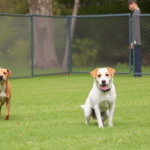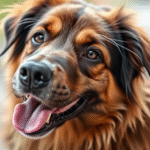The Calmest Dog Breeds for Families and Individuals
When it comes to choosing a pet, many families and individuals seek out a calm and gentle companion. The right dog can provide countless memorable moments while ensuring a peaceful atmosphere in your home. Thankfully, certain dog breeds are known for their tranquil nature, making them the ideal choice for various lifestyles. Let’s explore some of the calmest dog breeds that you might consider bringing into your life.
Calm Dog Breeds for Families
Families often look for dogs that are patient, friendly, and tolerant, especially if there are children around. Here’s a list of some dog breeds that fit these criteria:
- Golden Retriever – Known for their friendly disposition, Golden Retrievers are gentle, loyal, and very sociable. They thrive in family settings and easily adapt to various environments.
- Newfoundland – These giant dogs are known as “gentle giants.” They are incredibly calm and patient, often forming strong bonds with children and being a protective presence.
- Bulldog – Bulldogs are easy-going and love lounging around. Their slightly lazy nature makes them great companions for families that enjoy a relaxed pace.
- Basset Hound – Basset Hounds are laid-back and easy to train. Their calm demeanor suits families that prefer quiet companionship.
- Shih Tzu – This breed is known for its affectionate nature and love for being around people. Shih Tzus are small and gentle, making them great pets for families with youngsters.
Tranquil Choices for Individuals
If you’re an individual looking for a calm companion, you may also want to consider these breeds:
- Cavalier King Charles Spaniel – This breed is affectionate, adaptable, and thrives on human interaction. Cavaliers enjoy curling up beside you for a cozy evening.
- Great Dane – Despite their size, Great Danes are known for being gentle and loving. They have a calm demeanor and are typically good with both kids and adults.
- Irish Wolfhound – These large dogs are surprisingly calm and peaceful. They are often known as quiet companions, making them an excellent choice for individuals looking for a serene presence.
- French Bulldog – French Bulldogs possess a playful yet laid-back personality. They love to relax and require minimal exercise, making them suitable for apartment living.
- Mastiff – Mastiffs are giant softies. With their wise, gentle nature, they make great companions for anyone seeking a loyal, calm dog.
The Characteristics of Calm Dogs
While many breeds may be known for their calm temperament, individual personality traits play a significant role as well. A calm dog is often characterized by:
- Low Energy Levels – These dogs are less likely to be hyper and often prefer relaxing to going on wild adventures.
- Gentle Behavior – Calm breeds are patient and don’t exhibit irritability easily, making them suitable for families with small children.
- Affectionate Nature – Many calm dogs love to cuddle and be close to their humans, making them excellent companions.
- Good with Training – A calmer dog is often easier to train as they tend to focus better and respond well to commands.
Factors to Consider When Choosing a Calm Dog
While selecting any dog breed, consider your living situation, lifestyle, and the amount of time you can devote to training and socialization. Calmer breeds often still require regular exercise and mental stimulation to keep them content. Additionally, visiting local shelters or breed rescues allows you to meet various dogs, giving you a sense of their temperament before making a commitment.
If you want to dive deeper into dog breeds and their characteristics, visit the American Kennel Club. You can find valuable resources that can assist you in making the best choice for your family or individual requirements. Another great resource is Petfinder, which can help you find calm dogs in shelters near you.
In choosing a calm dog, remember that every dog has its personality. Spend time getting to know them, and you may just find your perfect, peaceful companion.
Benefits of Owning a Calm Dog
When considering a canine companion, many people seek a dog that embodies calmness and tranquility. Owning a dog that exhibits a calm demeanor can lead to numerous benefits for both the pet and the owner. A calm dog tends to create a harmonious environment, which can significantly enhance the quality of life for everyone involved.
One of the most notable advantages of having a calm dog is the positive impact on mental health. Dogs are known for their exceptional ability to provide emotional support. A calm dog can help reduce feelings of anxiety and stress, offering a soothing presence during challenging times. The simple act of petting a dog can release serotonin and dopamine, hormones associated with happiness and wellbeing. This effect helps you feel more relaxed and content in your daily life.
Moreover, calm dogs can positively influence family dynamics. In households with children, having a calm dog helps teach kids about responsibility and empathy. Children learn to interact with animals kindly and compassionately, fostering a sense of nurturing. A calm dog is generally more patient and tolerant, which instills confidence in children as they engage and play with their furry friend.
In addition to emotional benefits, calm dogs often have lower exercise requirements, making them suitable for a broad range of lifestyles. Busy individuals or families can manage a calm dog without the pressure of rigorous daily exercise. For instance, breeds like the Basset Hound or the Bulldog prefer leisurely strolls rather than long runs. This quality can be especially reassuring for those who have a tight schedule but still wish to enjoy the companionship of a dog.
Another advantage is the compatibility of calm dogs with various living environments. Whether you live in a small apartment or a larger home, calm dogs adapt well to different spaces. Their low energy levels mean they are less likely to engage in destructive behaviors often caused by pent-up energy, making them particularly well-suited for environments with limited space.
Calm dogs also tend to be easier to train than their more energetic counterparts. Their steadiness allows for better focus during training sessions, making it easier for owners to instill commands and good behavior. With patience and consistency, you can teach your calm dog various tricks, reinforcing obedience and strengthening your bond.
The presence of a calm dog can facilitate social interactions as well. You may find that having a calm dog makes you more approachable to others, helping to create connections with fellow dog lovers. Calm dogs are often welcomed in more public spaces, and their demeanor can encourage friendly conversations, making outings enjoyable for you and potential new friends.
Here are some of the benefits of owning a calm dog:
- Promotes emotional wellbeing by reducing stress and anxiety.
- Enhances learning opportunities for children about empathy and responsibility.
- Requires less exercise, fitting well into a busy lifestyle.
- Adapts easily to various living environments.
- Easier to train due to their focus and steadiness.
- Encourages social interactions in various settings.
Calm dogs often exhibit fewer behavioral issues. Their serene nature makes them less likely to bark excessively, chew furniture, or engage in other disruptive behaviors typically associated with high-energy dogs. This harmonious atmosphere can result in a more peaceful home environment where you and your dog can thrive together.
The benefits of owning a calm dog are extensive and profound. Whether you’re seeking emotional support, companionship, or simply a pet that fits well with your lifestyle, a calm dog may be the perfect choice for you. If you’re interested in learning more about different dog breeds and their temperaments, consider exploring [American Kennel Club](https://www.akc.org) or [Petfinder](https://www.petfinder.com) for further insights.
In essence, owning a calm dog not only enhances your life but also fosters a nurturing companionship that can be cherished for years. Enjoy the tranquility that a calm dog can bring!
Training Techniques to Enhance Calmness in Dogs
Calmness is a cherished trait in dogs, bringing peace to both pets and their owners. However, achieving this quality often requires dedication and the right training techniques. By fostering calmness in your dog, you create a harmonious environment that benefits everyone in the household.
Understanding your dog’s behavior is essential. Dogs, like humans, have different temperaments and energy levels. To enhance calmness, the first step is to identify what triggers excitement or anxiety in your dog. Common triggers include loud noises, unfamiliar environments, or even certain types of interactions with other dogs.
Positive Reinforcement
Positive reinforcement is a powerful training technique that encourages desired behaviors through rewards. This method relies on offering food, praise, or affection when your dog remains calm in situations that usually excite them. By consistently rewarding calm behavior, your dog learns that remaining relaxed is beneficial.
Step-by-Step Guide:
- Identify Triggers: Observe what situations lead to excitement or stress in your dog.
- Stay Calm: Your demeanor during training is crucial. Dogs often pick up on their owners’ emotions.
- Reward Calmness: When your dog behaves calmly around a trigger, provide immediate rewards.
- Gradually Increase Exposure: Slowly expose your dog to triggers and continue to reward calmness.
By following these steps, you will be instilling a sense of tranquility in your dog over time.
Consistency is Key
Consistency in training is vital in enhancing calmness. Dogs thrive on routine, and practices that are consistently applied help them feel secure. Ensure all family members are on the same page regarding training commands and rewards.
Tips for Consistency:
- Use the same commands when asking your dog to stay calm.
- Establish predictable routines for daily activities such as feeding and walking.
- Practice training exercises frequently, making them a regular part of your dog’s day.
Remember, dogs learn best when they can predict what comes next, and consistency builds their confidence.
Relaxation Techniques
Relaxation techniques into your dog’s daily routine can significantly enhance calmness. Techniques such as deep pressure therapy, calming music, and gentle massages can all work wonders.
| Relaxation Technique | Benefits |
|---|---|
| Deep Pressure Therapy | Provides comfort and a sense of security. |
| Calming Music | Reduces anxiety and encourages relaxation. |
| Gentle Massage | Helps release tension in muscles, promotes bonding. |
Consider setting aside time each day for these relaxation techniques. This not only helps calm your dog but also strengthens your bond.
Physical Exercise
A tired dog is often a calm dog. Regular physical exercise is essential for maintaining your dog’s energy levels. Incorporate playtime, walks, and even agility exercises to keep your dog fit both mentally and physically. A well-exercised dog is less likely to engage in unwanted behaviors born from excess energy.
Recommended Activities:
- Daily walks: Aim for at least 30 minutes every day.
- Fetch: A fun game that provides physical and mental stimulation.
- Agility training: Engages your dog’s mind and body.
Physical activity is vital for reducing stress and enhancing overall calmness in dogs.
Calm Environment
Creating a tranquil environment is also crucial. Designate a space in your home where your dog can relax. This quiet area should be free of distractions, loud noises, and overly stimulating toys. Utilize calming scents, such as lavender, to further promote relaxation.
Seeking expert guidance can also be beneficial. Consider consulting a professional dog trainer or behaviorist familiar with positive reinforcement techniques. They can offer personalized strategies tailored to your dog’s unique needs.
For more insights on dog training techniques, check out AKC Training Resources or Cesar’s Way. These resources provide further guidance to help you train your dog effectively.
Enhancing calmness in dogs is a rewarding journey. By implementing these techniques and being patient, you can nurture a serene relationship with your beloved pet.
The Role of Temperament in Choosing a Dog
When choosing a dog, one of the most critical factors to consider is temperament. Each dog has a unique personality that shapes its behavior and compatibility with your lifestyle. Understanding the role of temperament in selecting the right canine companion can lead to a harmonious relationship and a well-adjusted pet.
Dog breeds vary significantly in temperament, so it’s essential to assess your personal needs and lifestyle first. Here are some factors to consider when evaluating dog temperament:
- Energy Level: Some dogs are highly energetic, requiring ample exercise and stimulation. Others are more laid-back and content with a slower pace. If you’re someone who enjoys outdoor activities, breeds like Labrador Retrievers may suit you well. Conversely, if you prefer a couch potato, consider a breed like a Basset Hound.
- Socialization Needs: Some dogs thrive on social interaction, while others are more independent. Breeds like Golden Retrievers are known for their friendliness and love for social settings. In contrast, breeds like Shiba Inus may prefer limited interaction with strangers.
- Trainability: Certain breeds are more willing to please and easier to train than others. Breeds such as Poodles are highly intelligent and responsive, making training enjoyable. Conversely, dogs like Bulldogs might be more stubborn and require consistent training methods.
- Family Dynamics: If you have children or other pets, it’s crucial to select a dog whose temperament is compatible with your family situation. Breeds such as Beagles are generally good with kids and other animals, whereas some working dogs might be more reserved and less tolerant of chaos.
Another aspect to consider is the dog’s history and socialization experiences. Rescue dogs or those from shelters may have a variety of behavioral traits based on their past. Meeting a dog’s temperament through direct interactions can provide insights that breed characteristics do not fully capture. If possible, spend time observing the dog in various environments and situations before making a decision.
| Dog Breed | Temperament | Best For |
|---|---|---|
| Beagle | Friendly, curious | Families, active individuals |
| Bulldog | Gentle, affectionate | Low-energy households |
| Labrador Retriever | Outgoing, friendly | Active families, first-time dog owners |
| Shih Tzu | Affectionate, alert | Apartment dwellers, seniors |
Understanding a dog’s breed traits is just the beginning. In addition to breed characteristics, individual dogs also display unique personality traits. Spend time with potential pets to gauge their behavior. Look for signs of anxiety, aggression, or overexcitement, as these can significantly impact your decision.
Another way to get deeper insights into temperament is to consult with a dog trainer or behaviorist. These professionals can provide valuable assessments based on their experience working with various breeds and individual dogs. They may even help connect you with breeds or dogs whose temperaments align with your lifestyle.
Consider adopting from a reputable shelter or rescue organization. Many shelters assess dogs for their temperamental qualities before placing them for adoption. Organizations often provide details on the behavior patterns of their dogs, which can be extremely useful for finding a suitable match.
Choosing a dog based on temperament is crucial for the well-being of both you and your furry friend. A well-matched dog can not only bring joy to your life but also ensure a smoother journey in your shared experiences. For more information on dog temperaments and compatible breeds, visit the American Kennel Club.
How Environment Affects a Dog’s Calmness
Every dog is unique, and their temperament can largely depend on their environment. Whether you have a hyperactive pup or a laid-back canine, the surroundings you provide can significantly impact their calmness. Understanding how different factors play a role can help you create the most serene atmosphere for your furry friend.
Home Environment
The space where you live contributes significantly to your dog’s calming demeanor. A clutter-free, quiet home reduces anxiety in dogs. Here are some elements of a home environment to consider:
- Noise Levels: High noise levels from traffic, construction, or loud music can stress dogs. Creating a peaceful space with soft music or calming sounds can enhance their calmness.
- Space Size: Smaller spaces can lead to feelings of confinement. Providing your dog with enough room to move around and explore can reduce restlessness.
- Familiarity: A well-known environment, complete with familiar scents, toys, and bedding, can help dogs feel more secure and relaxed.
Interaction with Family Members
How you and your family engage with your dog is also influential in promoting calmness. Dogs are social animals and thrive on interaction. Here’s how family dynamics can contribute to a dog’s tranquility:
- Consistent Routine: Dogs feel calmer when they have a consistent daily routine for feeding, walks, and playtime. Predictability helps them feel secure.
- Positive Reinforcement: Rewarding calm behavior with treats, praise, or playtime encourages your dog to stay relaxed.
- Quality Time: Spending time with your dog in low-energy activities like cuddling or gentle petting helps them associate your presence with comfort.
Outdoor Environment
The outdoor environment also greatly affects your dog’s calmness. Environments that are too stimulating may overwhelm your dog. Consider these aspects:
- Park Conditions: Busy dog parks may excite or stress some dogs. A quiet park or a calm walk around the neighborhood may be better for more anxious dogs.
- Natural Spaces: Nature provides a soothing atmosphere with its serene sounds and sights. Regular walks in such environments can enhance a dog’s peace of mind.
- Weather Conditions: Hot and humid weather, or extreme cold, can make dogs uncomfortable. Ensuring your dog is cool or warm enough will help them stay calm.
Training and Mental Stimulation
A dog’s mental stimulation plays a crucial role in their overall calmness. Here are ways training can impact behavior:
- Regular Training Sessions: Engaging in regular training and mental exercises can tire out your dog, encouraging relaxation afterward.
- Interactive Toys: Providing toys that challenge and stimulate your dog’s mind can keep them occupied and reduce anxiety.
- Socialization: Introducing your dog to various environments and other pets can help them adapt and remain calm in new situations.
Health Factors
Don’t forget that a dog’s physical health can also impact their behavior. Health issues can make a dog irritable and restless. Keeping a regular vet check-up routine ensures your dog remains in good health, which can contribute to their calmness.
If you want to explore more about creating a tranquil environment for your dog, consider visiting this resource from the American Kennel Club. They provide useful tips on managing anxiety in dogs and creating a peaceful home environment.
Ultimately, to answer the question of what the calmest dog to own is, it’s not just about the breed; it’s significantly influenced by how you balance the environmental needs of your dog. By paying close attention to these factors, you can foster a more serene life for your furry companion, helping them to feel calm and content within their environment.
Tips for Ensuring a Calmer Home for Your Dog
Creating a calm environment for your dog is crucial for their well-being and happiness. A serene atmosphere not only relaxes your furry friend but also helps to reduce anxiety and stress. Here are some effective tips to ensure a calmer home for your dog.
Establish a Routine
Dogs thrive on routine. Establishing a consistent daily schedule helps your dog feel secure. This routine should include feeding times, walks, playtime, and bedtime. With predictable patterns in their daily life, dogs can relax better, knowing what to expect. Additionally, regular exercise helps channel energy and reduces restlessness.
Create a Safe Space
Designate a specific area in your home where your dog feels safe. This could be a cozy corner with their bed, toys, and some blankets. A calm space allows them to retreat when feeling overwhelmed. Make sure the area is free from loud noises and distractions. Providing a safe haven contributes significantly to your dog’s overall comfort.
Use Relaxation Aids
There are various products on the market designed to promote relaxation in dogs. Some popular options include:
- Calm Collars: These collars are infused with calming scents, such as lavender, which can help soothe anxious dogs.
- Adaptil Diffusers: These plug-in diffusers release pheromones that mimic those produced by a mother dog, creating a feeling of security.
- Calming Music: Many dogs respond positively to soft music. Playing calming tunes can help lower stress levels.
Encourage Training and Socialization
Training not only teaches your dog basic commands but also establishes boundaries. Regular socialization with other dogs and people builds confidence. A well-trained and socialized dog is less likely to exhibit anxious behaviors. Consider enrolling your dog in a training class to strengthen these skills. This will help them navigate new experiences without fear.
Maintain a Calm Demeanor
Your mood can greatly influence your dog’s behavior. Dogs are intuitive creatures and can sense stress in their owners. To foster a calm home, try to remain relaxed and composed. Avoid yelling or sudden loud noises. Speak to your dog in a soothing tone, especially during training or moments of excitement. This environment encourages tranquility.
Provide Interactive Toys
Boredom can lead to destructive behavior. Engaging toys keep your dog mentally stimulated and help relieve pent-up energy. Puzzle feeders, chew toys, and treat-dispensing balls are excellent choices. Interactive playtime reduces anxiety by focusing your dog’s attention on a fun activity.
Control the Environment
Make adjustments to your home to limit stress triggers. This may include:
- Soundproofing: If your dog is sensitive to loud sounds, consider soundproofing parts of your home or playing white noise.
- Temperature Control: Ensure your home is a comfortable temperature. Dogs can get anxious if they are too hot or cold.
- Limiting Visitors: While socializing is important, too many visitors can overwhelm your dog. Plan gatherings when they can relax or create a separate space for them during social events.
Regular Vet Check-Ups
Routine veterinary visits are essential for your dog’s health and comfort. Addressing any underlying health issues can significantly improve their behavior at home. If your dog is exhibiting unusual anxiety, consult with a veterinarian to rule out any medical problems. They can also recommend professional training or behavior therapy tailored to your dog’s needs.
Recommended Resources
For more information on creating a calm environment for your dog, here are some helpful resources:
- American Kennel Club: Dogs Need To Relax
- Dogster: Create a Calm Home for Your Dog
- The Spruce Pets: Calm Home Environment
By following these tips, you can create a peaceful environment for your dog, fostering happiness and a sense of security in their life. Your effort in nurturing a calm home will lead to a happier, healthier pet!
Recognizing Stress Signals in Dogs and How to Address Them
Understanding your dog’s stress signals is crucial for ensuring their happiness and well-being. Just like humans, dogs experience stress. They may not be able to articulate their feelings verbally, but they communicate through body language and behaviors. Recognizing these signals is the first step towards helping your furry friend feel more comfortable and secure.
Common Stress Signals in Dogs
When dogs are stressed, they may exhibit a variety of behaviors. Here are some common signals to watch for:
- Panting: Excessive panting, even in a cool environment, can indicate anxiety.
- Whining or Barking: Dogs may vocalize more when they are feeling stressed.
- Avoiding Eye Contact: If your dog turns away or avoids looking at you, it might be a sign of discomfort.
- Yawning: Dogs sometimes yawn as a way to cope with stress.
- Body Language: Look for stiff body posture, tucked tails, or lowered ears, as these can indicate stress.
- Excessive Grooming: Some dogs may lick their paws or other areas of their body when stressed.
- Destructive Behavior: Chewing or digging can be a sign of anxiety in dogs.
Identifying Stress Triggers
Every dog is unique, and their stress triggers can vary widely. Some common triggers include:
- Loud Noises: Thunderstorms, fireworks, or even heavy traffic can unsettle your dog.
- Strange Environments: Moving to a new home or traveling can cause anxiety.
- New People or Pets: Introducing your dog to unfamiliar individuals can be stressful.
- Separation Anxiety: Dogs may struggle when left alone for extended periods.
How to Help a Stressed Dog
Once you’ve recognized the stress signals and identified possible triggers, there are several strategies to help your dog cope:
- Create a Safe Space: Designate a quiet area in your home where your dog can retreat when feeling overwhelmed.
- Provide Comfort Items: A favorite toy or blanket can offer reassurance during stressful situations.
- Use Calming Products: Consider products like anxiety wraps or pheromone diffusers to help soothe your dog’s nerves. Check out calming products at ThunderShirt.
- Exercise Regularly: Regular walks and playtime can help reduce anxiety and improve your dog’s mood.
- Practice Training Sessions: Positive reinforcement training not only provides mental stimulation but also builds your dog’s confidence.
Professional Help
If your dog’s stress signals are persistent or severe, it may be time to seek professional help. A veterinarian can rule out any medical issues that may be contributing to your dog’s anxiety. Additionally, a professional dog trainer or animal behaviorist can offer specialized advice tailored to your dog’s needs.
The Importance of Routine
Establishing a consistent daily routine helps reduce stress in dogs. Make sure they have regular feeding times, exercise, and play. When dogs know what to expect, they generally feel more secure. Moreover, incorporating calming activities into their routine, such as puzzle toys or gentle massage, can promote relaxation.
Continual Monitoring
Keep observing your dog for changes in behavior as they can signal ongoing stress. Always remember that stress doesn’t disappear overnight. Be patient with your dog as they adjust to new situations and continue to provide love and support.
For further insights on understanding and managing canine stress, you may find the resources at American Kennel Club informative.
With attention and care, you can create an environment that fosters peace and happiness for your furry friend. By recognizing stress signals and understanding how to address them, you can enhance your dog’s quality of life, ensuring they are a happy and healthy member of your family.
Key Takeaway:
When considering the journey of dog ownership, understanding the concept of calmness in dogs is essential. This article highlights several key points regarding the calmest dog breeds, the benefits of choosing a calmer companion, effective training techniques, the importance of temperament, environmental influences, and how to maintain a serene home where your dog can thrive.
Firstly, certain dog breeds are naturally more serene than others, making them a perfect fit for families and individuals seeking a less hectic pet experience. Breeds like the Basset Hound, Cavalier King Charles Spaniel, and Bernese Mountain Dog are renowned for their chill demeanor. These breeds can provide a sense of companionship without excessive energy that could overwhelm owners, especially those with busy lifestyles or young children.
Owning a calm dog brings numerous advantages. These dogs tend to be easier to manage in varying social situations, providing comfort and security to their owners. Their tranquil nature makes them ideal therapy dogs, helping to reduce stress in environments like hospitals and schools. Additionally, the presence of a calm dog can foster a peaceful home atmosphere, benefiting all family members by promoting relaxation.
Training plays a vital role in nurturing a dog’s calmness. Employing techniques such as positive reinforcement, consistent routines, and regular training sessions can significantly enhance a dog’s temperamental balance. It is essential to engage with your dog through play and mental stimulation, which can transform an overly energetic pet into a more relaxed companion.
Understanding that a dog’s calmness is influenced by temperament is crucial. When selecting a dog, consider its natural disposition along with your lifestyle. Furthermore, the environment where a dog lives greatly impacts its behavior. A calm home filled with gentle stimuli, comfortable spaces, and predictable routines helps facilitate peace for your pet.
Dog owners should be attuned to the stress signals their pets exhibit, such as pacing, excessive barking, or hiding. By recognizing these signs and addressing the underlying issues—whether through environmental adjustments or additional training—owners can promote a calmer state for their dogs.
The journey to finding the calmest dog to own encompasses careful breed selection, mindful training approaches, and environmental considerations. By focusing on these aspects, you can cultivate a nurturing relationship with a dog that complements your life’s tranquility.
Conclusion
Finding the calmest dog to own is a journey that requires thoughtful consideration of both the breed and your living environment. The calmest dog breeds, such as the Bulldog, Basset Hound, and Cavalier King Charles Spaniel, are often ideal for families and individuals seeking a low-energy companion. These breeds not only contribute to a serene home atmosphere but also provide various emotional and physical benefits. Owning a calm dog can lead to reduced stress levels for both you and your furry friend, enhancing your overall quality of life.
To nurture calmness in your dog, training techniques such as positive reinforcement and consistency play crucial roles. Understanding that temperament can vary greatly between individual dogs, it’s important to choose a breed that aligns with your lifestyle. Creating a peaceful environment also significantly impacts your dog’s ability to remain calm. You can achieve this by reducing noise, providing a comfortable space, and establishing routines that help your dog feel secure.
Recognizing stress signals in your dog is vital. Look for signs such as excessive barking, pacing, or changes in behavior to address any anxiety quickly. By actively engaging in your dog’s well-being and implementing calming strategies, you can ensure a tranquil home atmosphere for both you and your pet. The journey to finding the calmest dog to own involves a blend of the right breed selection, proper training, and a stress-free environment, all contributing to a harmonious and fulfilling life together.







Leave a Reply